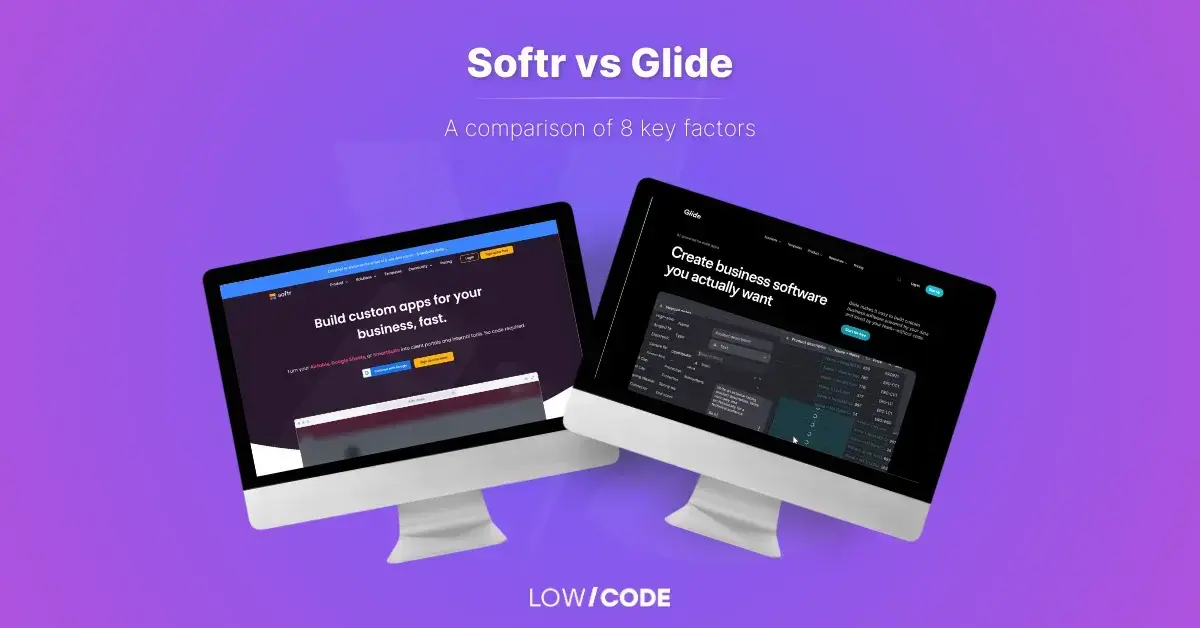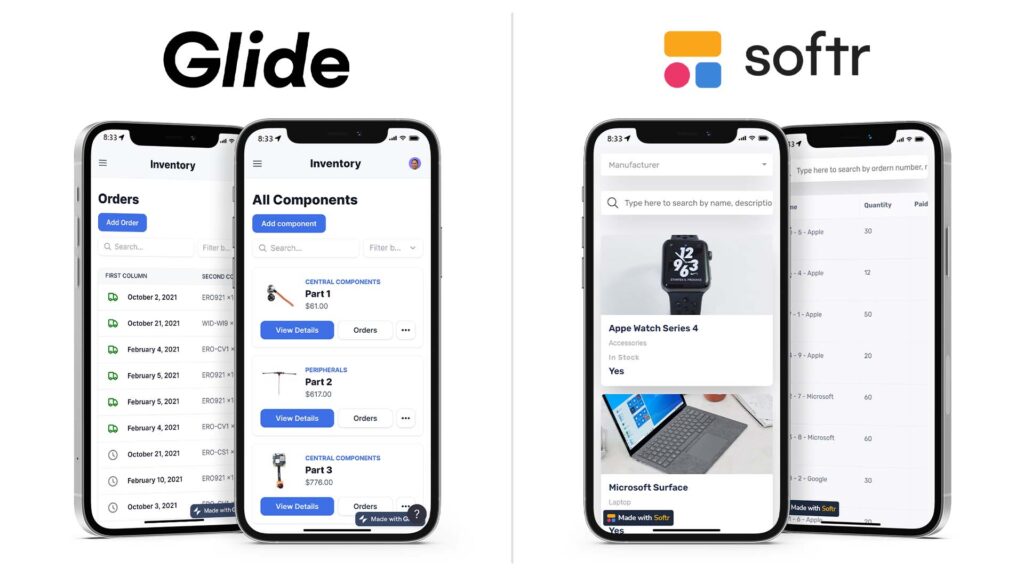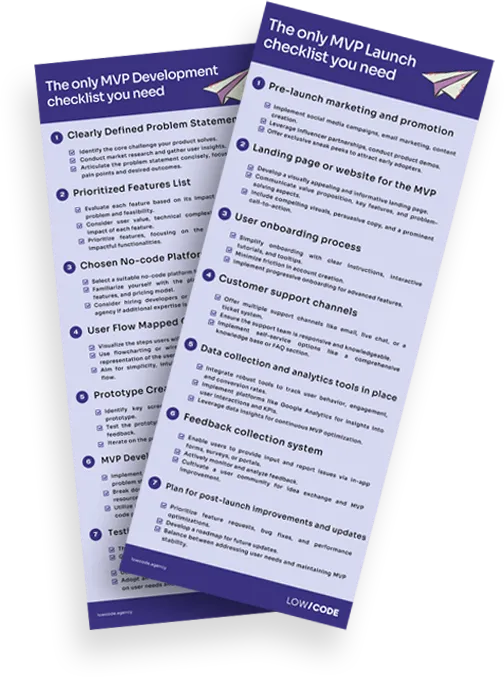
Softr vs Glide: A comparison of 8 key factors
Are you wondering what app builder to use for your next project? Choosing the right platform can make all the difference, but of course, you already know that. That’s why in this article we’ll help you explore in depth these two popular app-building platforms: Glide and Softr.
We’ll break down and compare their unique features, automation capabilities, security measures, design options, and more. Here at LowCode Agency, we’re experts in no-code/low-code app development, and we’ve built hundreds of apps. Now, we are happy to share our insights and recommendations to help you in making informed decisions for your app development. Join us on this exploration!
TL;DR
Glide stands out for its comprehensive set of features, including powerful automation, extensive data source integration, advanced security measures, and robust design flexibility. It is suitable for users seeking a high level of customization and automation capabilities.
Softr offers a simpler interface, that might feel outdated. It could be preferable for users who prioritize simplicity, especially for projects where extensive automation and customization are not the primary requirements.
Overview: platform UI, features, and capabilities

Glide
Glide gained popularity in its beginnings for effortlessly turning spreadsheets into apps, and it's come a long way from its Google Sheets roots. It has since expanded to include various data sources while maintaining its spreadsheet integration roots, which is still great for users to optimize existing tools without the hassle of extensive data sourcing.
With a sleek and modern user interface, it's a breeze to create visually appealing apps in record time. The platform strikes a balance, offering a soft learning curve—making app creation straightforward, even with its powerful features.
“Glide is so easy to use, and did I mention beautiful crafted too? The product was thoughtfully designed, my app creation needs are anticipated and answered.“
Amanda Chew, Product at Horizon Quantum Computing
Softr
Softr takes a simpler approach, but some users find it's a mixed bag. While the platform claims a "0 learning curve," some users beg to differ, finding Softr apps more complex to build and potentially pricier due to longer development times. There are reported constraints in building dynamic UIs, limited options for table layouts, and challenges with data visualization. Despite these hurdles, Softr aims for simplicity, even if it means sacrifices in certain features.
"Softr is a great tool to build websites. Although as a developer, I find it inflexible, lack of features, basically hard to build scalable and complex websites. Although great option for basic to moderately complex website.”
Sain, Developer • Data Scientist
Responsiveness
Glide
Glide is actually the gold standard for responsiveness. If your app is responsive, it will be much more user-friendly, overall, more seamless to use. Professional app and software developers know how important responsiveness is, and low code/no code allows users to achieve a responsive app without having to write code. However, it is important to keep responsiveness in mind when choosing your no-code app builder.
Softr
Unfortunately, Softr doesn’t yet make very responsive apps. This is paradoxical because they make PWA (Progressive Web Apps), which are designed to run smoothly on all devices. If your priority is for your app to be responsive, we don’t recommend going with Softr for the time being.

Design, customization, and templates
Glide
Glide offers a lot of design freedom, they clearly give importance to aesthetics in app development. With layout tools, themes, and custom design elements, users have the flexibility to create visually appealing apps. For those wanting even more design control, the business plan allows the integration of CSS into Glide pages, an extra layer of customization.
Softr
While Softr is capable of creating beautiful apps, it may not match Glide's level of design flexibility. According to some opinions, Softr offers fewer personalization options, making it potentially harder to achieve highly aesthetic designs. However, design preferences can be subjective, and Softr has been used to create numerous visually appealing apps.
Softr offers the “custom code block” feature for users on the Basic plan and above. The custom code block allows users to insert snippets of code, including HTML, CSS, and JavaScript, into their applications. This code snippet is added inside the <body> HTML element, so users can incorporate it at various points.
Both Softr and Glide have libraries of templates covering various use cases. Whether it's internal tools, CRM, or e-commerce, users are likely to find templates that suit their needs. Starting with a template can be advantageous, making modifications is much easier than creating everything from scratch.
We have published some very useful Glide templates! Check them out to start building fast.
Security
Glide
Glide prides itself on robust security features, especially crucial for apps dealing with sensitive information or payments. They've built in multiple layers of security, tapping into open-source tools, automated vulnerability scans, and even conducting independent penetration tests and security audits.
Several security measures will be automatically implemented, but you, as the app creator will maintain control over key security decisions. You’ll have the power to control who can do what within your app. Granular permissions enable you to decide who manages, views and edits your app. If your app involves data that requires extra protection, Glide allows you to restrict access to specific rows based on email addresses. And by default, new Glide apps are private. You have the flexibility to adjust privacy settings, making the app public, available to specific users, or accessible via particular email domains.
Of course, Glide regularly releases security updates to patch vulnerabilities and improve the overall security posture of their platform. Also, the platform adheres to GDPR and SOC 2, which means they have implemented appropriate technical and organizational measures to meet these strict industry standards for data privacy and security.
“Glide is a secure and reliable platform. Your data is encrypted and hosted in the cloud, and Glide offers a 99.9% uptime guarantee.”
Gary W.- Small-Business Owner
Softr
The documentation available on Softr’s security aspects is more limited and not as thorough as Glide’s. Softr takes a server-side approach to security, providing a robust defense against client-side manipulation and unauthorized data access. They dynamically evaluate user groups, block and page visibility rules, and data conditional filters on the server side. This ensures that users only see what they are supposed to, reducing the risk of data breaches.
Softr limits potential security vulnerabilities by working strictly with the tables and fields configured within blocks. Interaction with the data source occurs via API with short-term caching, avoiding the creation of unnecessary data copies that could potentially compromise security. Of course, all communication between the server side and data sources is encrypted using HTTPS, an extra layer of security during data transfer.
Data sources
Glide
If they want to, Glide allows users to keep their data exclusively within Glide using their native data source, Glide Tables. Users can build tables from scratch in the Data Editor, and the Glide Tables API is available for connecting tables with external applications and automating data management.
Glide supports integration with various external platforms and applications, including:
- Google Sheets
- Airtable
- Excel files in Microsoft OneDrive or SharePoint
- BigQuery
- PostgreSQL
- Google Cloud SQL
- MySQL
- SQL Server
Additionally, the Glide Tables API is a new feature that allows developers to programmatically access the data stored in Glide Tables. This provides the ability to build custom integrations and automate workflows involving Glide Tables data using HTTP requests and RESTful principles. It also supports API key authentication.
Wondering just how much a Glide app can help your business?
See how the solution we’ve built for Known.dev reduced their support inquiries by 40%!
Softr
Connecting a data source to Softr is optional, but it becomes necessary if you want to go beyond creating a simple website with static content. Softr is still expanding its list of supported data sources. As of now, it supports:
- Airtable
- Google Sheets
- SmartSuite (beta)
Both Glide and Softr allow users to connect multiple data sources from the same or different platforms. The more data sources a low-code/no-code app has, the easier it will fit into your current workflow and habits. You won’t have to spend hours transferring data onto your app, which is obviously a huge advantage.
Automation features
Glide
Glide offers robust automation features. From basic actions like adding a row or composing an email to more advanced functionalities like linking to screens or reshuffling data, Glide's automation capabilities are extensive.
The recent introduction of Glide Actions takes this a step further. Now, users can define custom actions for interactive elements within their apps. This feature opens up possibilities for creating multi-step processes, triggering emails, sending notifications, navigating users to specific screens, and more. Glide's focus on automation allows for the development of dynamic applications with powerful workflows.
Glide enables our team to simplify and visualise our large data sets into meaningful and readable content. If used in its full capacity, you can really make a significant difference in your team's workflows. We've done so countless of times in our team.
Ryan R. - Product Owner
Softr
Softr, on the other hand, doesn’t have strong automation options. The platform does not mention automation or action sequences on its website. While it allows users to connect with third-party workflow automation platforms like Make or Zapier, the native automation capabilities within Softr appear to be limited.
You can connect with third-party workflow automation platforms like Make or Zapier but that's as far as it goes (and still, you can do that too with Glide). So, overall, we don't think Softr is the best option if your project is going to need complex automation sequences.
3rd party integrations
Glide
Glide seamlessly integrates with various platforms, including:
- Automation Platforms: Zapier
- Analytics: Google Analytics
- Communication: Discord, Intercom, Slack, Twilio
- Documentation: Docusign, DocsAutomator
- Design: Pexels
- Productivity: Gmail, Google Calendar, Microsoft Outlook, Microsoft Teams
- Development: Make
- Data Management: Clearbit, Generate CSV
- Other: PDFMonkey, OpenAI, Push Notifications, Urlbox, Zendesk
Glide also provides API access for Pro/Enterprise level apps. The API allows users to integrate their app with external services and automate data updates. To keep things no-code, you can leverage a tool like Make, which acts as a bridge to connect your Glide app with other platforms.
Softr
Some of the platforms Softr offers integration with include:
- Analytics: Google Analytics, Fathom Analytics, Hotjar
- Communication: Crisp, Drift, HubSpot Chat, Intercom
- Payment: Stripe, Paypal, Gumroad, Buy Me a Coffee
- Marketing: Facebook Pixel, Google Tag Manager, Mailchimp, Mailerlite
- Form Tools: Typeform, Airtable Form
- Mapping: Google Maps
- Scheduling: Calendly, Google Calendar
- Media: Youtube, Vimeo, Pexels (Stock Photos), Font Awesome (Icons), Illustrations
Pricing
Glide
- Free:
Cost: $0
Ideal for: Individuals exploring Glide and building their first app
Includes: 1 published app, 10 personal users. Glide Tables data management. Real-time data sync.
- Maker:
Cost: Starting at $49/month (billed annually)
Ideal for: Individual creators or small teams building personal apps
Includes: 1 published app. Personal users only. Glide AI capabilities. Custom branding.
- Team:
Cost: Starting at $99/month (billed annually)
Ideal for: Teams collaborating on internal tools or apps
Includes: Unlimited apps. 5 editors, 20+ users. Glide Basic API access. 5,000 updates/month and 40,000 rows.
- Business:
Cost: Starting at $249/month (billed annually)
Ideal for: Building professional apps for larger user bases
Includes: Unlimited apps. 10 editors, 20+ users. Database connections. API calls. Optional single sign-on. 10,000 updates/month and 100,000 rows.
- Enterprise:
Cost: Custom pricing
Ideal for: Large organizations with specific needs and security requirements
Includes: Dedicated account manager. Custom pricing and features. Tailored SLAs.
Softr
- Free Plan:
Cost: Free
Ideal for: Individuals building passion projects
Includes: Unlimited app visitors, 5 internal / 100 external app users - 5 workspace collaborators - 1 custom domain
- Basic Plan:
Cost: $49/month
Ideal for: Entrepreneurs building new products
Includes: Everything in free and Custom CSS/JS, 10 internal / 1000 external app users - Ability to embed Softr apps -Option to purchase extra custom domains.
- Professional Plan:
Cost: $139/month
Ideal for: SMBs and agencies building portals and internal tools
Includes: Everything in Basic and additional features like Charts, Calendar, Inbox, Kanban -50 internal / 5000 external app users - 10 workspace collaborators - Removal of Softr branding.
- Business Plan:
Cost: $269/month
Ideal for: Teams building advanced custom apps
Includes everything in Professional, plus: Advanced features like Org chart, Timeline, SMS login - 100 internal / 10000 external app users - 15 workspace collaborators - Downloadable mobile apps (PWA).
- Enterprise Plan:
Cost: Custom (Contact Softr for details)
Ideal for: Larger companies requiring extra volume, security, and support
Includes: Everything in Business and SSO for app users (SAML, OpenID) - Security audit - Dedicated success manager - Team training - Custom invoicing.
Pros and cons
Who wins?
It really is difficult to choose between two low-code/no-code tools. It will depend on the specific needs and priorities of your project. Softr may be a suitable option for simple use cases, like client/partner portals, small internal tools, community hubs etc., but you have to be aware of its limitations.
We think that if your goal is to build a powerful, scalable app with a high-quality design, Glide could be the better choice. Glide's data management, robust automation features, design flexibility, and direct integrations, make it a strong contender for more complex projects. Both platforms have their strengths, so it's about finding the one that aligns best with your specific use case and preferences.
At LowCode, we have built many successful projects with Glide. Are you wondering if we can bring your vision to life too? Book a free consultation!




%20(Custom).webp)









.png)
